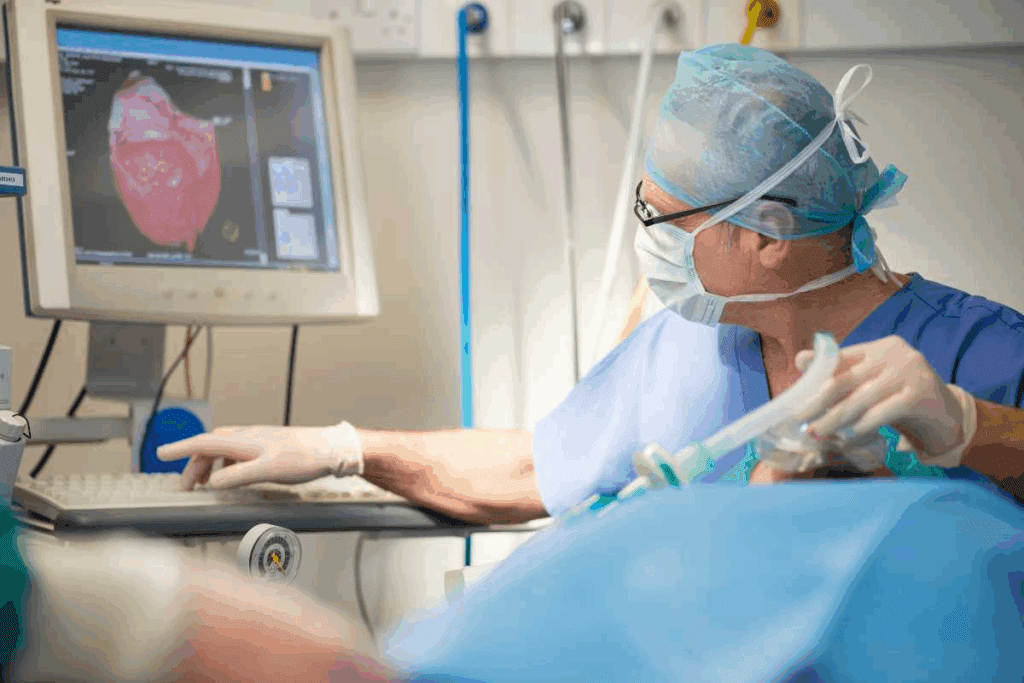
The heart needs a steady blood supply to work right. This supply comes mainly from the coronary arteries. The left main coronary artery (LMCA) and the right coronary artery (RCA) are key. They make sure the heart muscle gets enough oxygen.Learn how many main artery in heart and key coronary arteries explained clearly.
The coronary circulation is key for a healthy heart. The LMCA splits into the left anterior descending (LAD) and the left circumflex artery (Cx). The RCA helps the right side of the heart. Knowing about these arteries helps doctors find and fix heart problems.
Places like Liv Hospital focus on precise care. They understand the heart’s arteries well. They know how important coronary arteries are for heart health. They also know how blockages can hurt the heart.

Coronary arteries are key for bringing oxygen and nutrients to the heart. This lets the heart pump blood well across the body. We’ll look at how these arteries are vital for the heart’s work.
Coronary arteries carry oxygen-rich blood to the heart muscle. They start from the aortic sinuses and spread across the heart. The main ones are the left coronary artery (LCA) and the right coronary artery (RCA).
The LCA splits into the left anterior descending artery (LAD) and the circumflex artery (Cx). These supply the left ventricle and other heart parts. The RCA goes to the right ventricle and other areas.
The heart needs a good blood supply to work right. It gives oxygen and nutrients for the heart muscle to pump blood. Without enough, the heart can get ischemic, causing angina or myocardial infarction.
The coronary circulation changes to meet the heart’s needs. When we’re active, the arteries widen to boost blood flow. This helps the heart muscle get more oxygen.

The heart gets its blood from two main coronary arteries. Knowing about these arteries helps us understand how the heart works. It also helps us spot coronary artery disease.
The heart’s blood supply comes from the Left Main Coronary Artery (LMCA) and the Right Coronary Artery (RCA). The LMCA splits into the Left Anterior Descending artery (LAD) and the Left Circumflex artery (LCX). These supply different parts of the heart.
LMCA and its branches are key for the heart’s blood supply. They reach the left ventricle and the front part of the interventricular septum.
The LMCA and RCA start from the aortic sinuses. The LMCA comes from the left aortic sinus. The RCA starts from the right aortic sinus.
“The coronary arteries arise from the aortic sinuses, which are critical for their function in supplying the heart muscle with blood.” –
A leading cardiology textbook
The way coronary arteries spread out varies from person to person. But, the LMCA and RCA usually cover different heart areas.
| Coronary Artery | Region Supplied |
| LMCA (LAD and LCX) | Left ventricle, anterior part of the interventricular septum |
| RCA | Right ventricle, posterior part of the interventricular septum, and parts of the left ventricle |
Knowing how these arteries spread and work is key. It helps us diagnose and treat coronary artery disease well.
The LMCA is a key artery that starts from the left aortic sinus. It supplies a big part of the heart muscle with blood. Knowing its anatomy and function helps us understand the heart’s blood flow.
The LMCA begins in the left aortic sinus, just above the aortic valve. It goes between the pulmonary artery and the left atrial appendage. It’s about 3 to 6 mm wide and 1 cm long before splitting into its main branches. The lm heart artery is another name for the LMCA because it’s so important for the left side of the heart.
The LMCA splits into two big branches: the Left Anterior Descending artery (LAD) and the Left Circumflex artery (LCX). The LAD goes down the anterior interventricular groove to the heart’s apex. It supplies the front wall of the left ventricle and the interventricular septum’s front two-thirds. The LCX runs in the left atrioventricular groove, giving blood to the left ventricle’s sides and back. The om heart vessel or obtuse marginal branches, which come from the LCX, are key for the left ventricle’s lateral wall.
The LMCA system supplies a big part of the heart. This includes the left ventricle’s front and sides, the interventricular septum’s front two-thirds, and sometimes the left atrium. The blood supply heart anatomy is closely tied to the LMCA’s reach, showing its key role in heart function. The LAD and LCX, as main branches, make sure the left side of the heart gets enough blood. This is essential for the heart’s output and health.
In summary, the LMCA is a vital artery in the heart’s blood flow. Its branches, like the LAD and LCX, are key for the left side of the heart. Knowing the LMCA’s anatomy, its branches, and what it supplies is key to understanding the heart’s blood flow and function.
The RCA is key to keeping the heart healthy by delivering blood. It’s one of the heart’s two main arteries, alongside the Left Main Coronary Artery (LMCA).
The RCA starts in the heart’s anterior aortic sinus. It then moves through the atrioventricular groove to the heart’s crux. Its path is vital because it branches off into several important areas.
Key aspects of the RCA’s anatomy include:
The RCA has several major branches that feed different heart areas. Two key branches are:
The RCA supplies blood to vital heart areas, including:
| Area Supplied | Description |
| Right Atrium | The RCA supplies the right atrium, ensuring its proper function in receiving deoxygenated blood. |
| Right Ventricle | The right ventricle receives its blood supply from branches of the RCA, enabling it to pump blood to the lungs. |
| Posterior Descending Artery (PDA) | In most individuals, the RCA gives rise to the PDA, which supplies the posterior aspect of the heart. |
Knowing how the RCA works is key for diagnosing and treating heart disease. It’s vital for the heart’s right atrium, right ventricle, and often the posterior heart area.
Knowing how blood flows to different heart parts is key to spotting heart disease. The heart’s arteries make sure each area gets the oxygen and nutrients it needs to work right.
The left ventricle pumps blood all over the body. It gets its blood mainly from the Left Anterior Descending (LAD) artery and the Left Circumflex (LCX) artery. The LAD covers the front and most of the middle part of the heart wall. The LCX covers the sides and back of the left ventricle.
This double supply is vital for the left ventricle. It needs a lot of blood to keep the high pressure needed for body circulation.
The right ventricle pumps blood to the lungs. It mainly gets its blood from the Right Coronary Artery (RCA). The RCA’s branches make sure the right ventricle gets enough blood to work well.
The atria get their blood from both the RCA and the LCX. The RCA usually feeds the right atrium, and the LCX feeds the left atrium. This way, both atria get enough blood, though it can change from person to person.
The septum, which divides the left and right ventricles, gets blood from both the LAD and the RCA. The LAD covers the front two-thirds, and the RCA covers the back third. This shared supply is key for the septum’s health and the heart’s function.
The coronary circulation system is key for the heart. It brings oxygen and nutrients to the heart muscle. This network of blood vessels is vital for the heart to work right.
Coronary circulation diagrams show how blood flows through the heart. They are important for seeing how the heart gets its blood supply.
Collateral circulation is a network of small blood vessels. They help when a main coronary artery is blocked. This can lessen damage during a heart attack.
Coronary circulation varies from person to person. Knowing these differences is key for diagnosing and treating heart issues.
Coronary circulation patterns are based on which artery supplies the posterior descending artery. Right dominance is common, but left dominance and co-dominance also exist.
| Coronary Artery | Areas of the Heart Supplied |
| Left Main Coronary Artery (LMCA) | Left ventricle, left atrium, and interventricular septum |
| Right Coronary Artery (RCA) | Right ventricle, right atrium, and parts of the conduction system |
| Left Anterior Descending Artery (LAD) | Anterior wall of the left ventricle and interventricular septum |
Understanding coronary circulation is key to knowing how the heart works. By looking at diagrams, collateral circulation, anatomy variations, and dominance patterns, we see the heart’s blood supply fully.
Understanding the role of coronary arteries is key to treating heart issues. These arteries are vital for blood flow to the heart. Any blockage can cause serious heart problems.
Coronary artery disease (CAD) happens when the arteries narrow or block. This is often due to atherosclerosis. Plaque buildup restricts blood flow to the heart. High blood pressure, high cholesterol, smoking, and diabetes are risk factors.
CAD can progress slowly. Symptoms may not show until it’s advanced. Regular check-ups and screenings are important for early detection.
Myocardial infarction, or a heart attack, happens when a coronary artery is blocked. This cuts off oxygen and nutrients to the heart. Recognizing symptoms like chest pain and shortness of breath is critical for quick medical help.
Several imaging techniques help diagnose CAD. These include:
Treatment for CAD aims to improve blood flow and manage symptoms. It includes:
Changing lifestyle is also key. This includes a healthy diet, regular exercise, and quitting smoking.
Keeping your coronary arteries healthy is key to a strong heart. We can protect them by making lifestyle changes, following medical advice, and watching for warning signs.
Living a heart-healthy lifestyle is the best way to protect your coronary arteries. This means:
Medical care is also vital for protecting your coronary arteries. This includes:
Knowing the signs of coronary artery issues can help you get help quickly. Look out for:
New research is exploring ways to better protect your coronary arteries. Some areas being studied include:
The coronary arteries are key to keeping the heart muscle alive. They bring oxygen-rich blood to the heart. Knowing how they work helps us understand the heart’s structure and function.
We’ve looked at the coronary arteries’ layout and their role in heart health. The left main and right coronary arteries are vital. They make sure the heart muscle gets the blood it needs to keep working.
It’s important to keep these arteries safe to avoid heart disease. By learning about the coronary arteries, we see how vital heart health is. This knowledge helps us take care of our hearts better.
The heart gets oxygenated blood from two main arteries. These are the left main coronary artery (LMCA) and the right coronary artery (RCA).
The LMCA is key for the heart. It splits into the left anterior descending (LAD) and left circumflex (LCX) arteries. These are essential for the heart’s work.
The RCA feeds the right atrium and ventricle. It also covers the heart’s back side in many people.
Coronary arteries give the heart muscle oxygen and nutrients. This lets the heart work well.
Coronary artery disease happens when arteries block. This cuts down blood flow to the heart. It can cause a heart attack.
Signs include chest pain and shortness of breath. These may mean the heart isn’t getting enough blood.
Eating well, exercising, and not smoking can help. These changes keep the coronary arteries healthy and lower disease risk.
Diagrams show the heart’s blood flow. They help spot problems and see how blockages affect the heart.
Collateral circulation is a backup blood vessel network. It helps when main arteries are blocked, keeping blood flowing to the heart.
Doctors use angiography to find the disease. Treatment might include medicines, angioplasty, or surgery.
Subscribe to our e-newsletter to stay informed about the latest innovations in the world of health and exclusive offers!
WhatsApp us